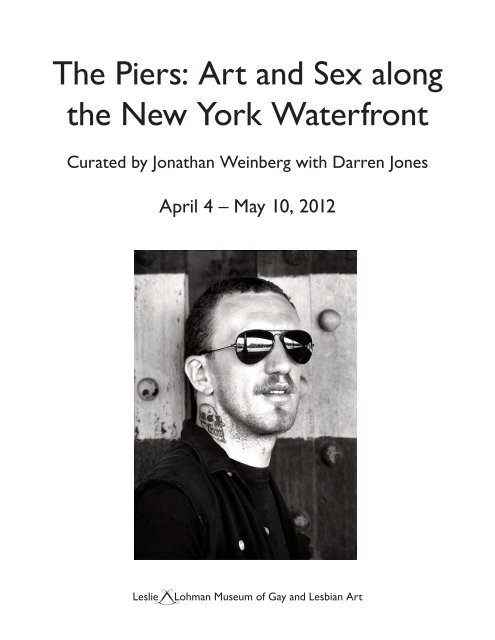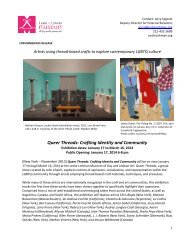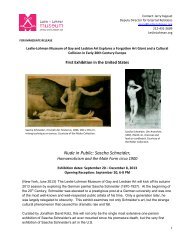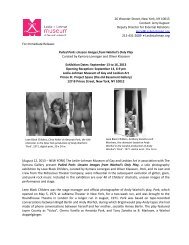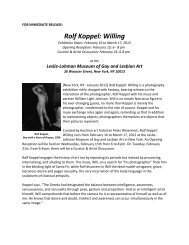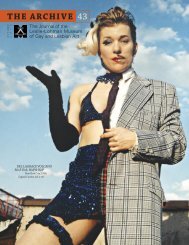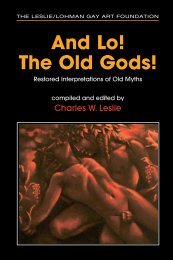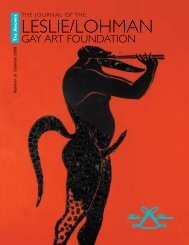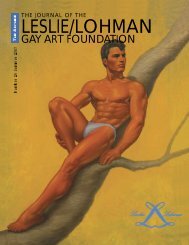The Piers - Leslie Lohman Museum of Gay and Lesbian Art
The Piers - Leslie Lohman Museum of Gay and Lesbian Art
The Piers - Leslie Lohman Museum of Gay and Lesbian Art
Create successful ePaper yourself
Turn your PDF publications into a flip-book with our unique Google optimized e-Paper software.
<strong>The</strong> <strong>Piers</strong>: <strong>Art</strong> <strong>and</strong> Sex along<br />
the New York Waterfront<br />
Curated by Jonathan Weinberg with Darren Jones<br />
April 4 – May 10, 2012<br />
<strong>Leslie</strong> <strong>Lohman</strong> <strong>Museum</strong> <strong>of</strong> <strong>Gay</strong> <strong>and</strong> <strong>Lesbian</strong> <strong>Art</strong>
City-Condoned Anarchy<br />
By Jonathan Weinberg<br />
“Why do gays love ruins?” I said to my friends when we emerged into the crisp autumn sunlight <strong>of</strong> a Sunday afternoon,<br />
“<strong>The</strong> Lower West Side, the docks. Why do we love slums so much?”<br />
“One can hardly suck cock on Madison Avenue, darling . . .”<br />
— Andrew Holleran, “Nostalgia for the Mud”<br />
Posted like silent sentinels all around the town, st<strong>and</strong> thous<strong>and</strong>s <strong>of</strong> mortal men fixed in ocean reveries. Some leaning<br />
against the piles, some seated upon the pier heads. But these are all l<strong>and</strong>smen; <strong>of</strong> week days pent up in lath <strong>and</strong><br />
plaster—tied to counters, nailed to benches, clinched to desks. How then is this? Are the green fields gone?<br />
What do they here?<br />
— Herman Melville, Moby Dick<br />
<strong>The</strong> <strong>Piers</strong>: <strong>Art</strong> <strong>and</strong> Sex along the New York Waterfront is the first museum exhibition<br />
to focus exclusively on the relationship <strong>of</strong> the uses <strong>of</strong> the Hudson River docks by<br />
artists <strong>and</strong> a newly emerging gay subculture. Between 1971 <strong>and</strong> 1983, the piers<br />
below Fourteenth Street were the site <strong>of</strong> an enormous range <strong>of</strong> works by artists<br />
as different in their mediums <strong>and</strong> intentions as Vito Acconci <strong>and</strong> Peter Hujar,<br />
Selley Seccombe <strong>and</strong> Tava, Gordon Matta-Clark <strong>and</strong> David Wojnarowicz. At<br />
the same time, the fight for the rights <strong>of</strong> gay, lesbian <strong>and</strong> transgendered people,<br />
spurred by the 1969 Stonewall riots, was literally transforming the cultural <strong>and</strong><br />
social l<strong>and</strong>scape <strong>of</strong> New York City. Stepping out <strong>of</strong> the closet in droves, gay men<br />
suddenly felt free to sunbathe on the piers naked, cruise <strong>and</strong> have sex in public.<br />
Within walking distance <strong>of</strong> the World Trade Center <strong>and</strong> the posh brownstones<br />
<strong>of</strong> Greenwich Village, this “arena for sexual theater,” as the painter Delmas Howe<br />
put it, became the backdrop for elaborate photographic tableaus, sometimes<br />
staged as in <strong>Art</strong>hur Tress’s picture <strong>of</strong> two naked figures in almost identical poses<br />
in adjoining rooms, or seemingly spontaneous, as in Stanley Stellar’s image taken<br />
from the ro<strong>of</strong>top <strong>of</strong> a man below giving a h<strong>and</strong> job to a fellow sunbather. a Other<br />
photographers like Alvin Baltrop, Frank Hallam, Shelley Seccombe, Lee Snider, <strong>and</strong><br />
Rich W<strong>and</strong>el, were intent on making a direct record <strong>of</strong> the collapsing structures,<br />
<strong>and</strong> the people that used them knowing that this strange world on the water’s<br />
edge would not last. b <strong>The</strong> expatriate<br />
filmmaker Ivan Galietti saw in the pier’s<br />
fire-scorched walls <strong>and</strong> obscene murals<br />
Stanley Stellar, Peter Gets His Dick Sucked, 1981,<br />
contemporary digital print, 42 1/8 x 28”<br />
Frank Hallam, Sunners, Pier 51 (Exterior from<br />
Interior), 1978/2011, archival digital print from slide<br />
18.5x12.5”<br />
an updated version <strong>of</strong> the ruins <strong>of</strong> Pompeii <strong>of</strong> his native Italy. <strong>The</strong>se same ruins<br />
were the perfect Arabian Nights backdrop for the famous avant-gardist Jack Smith<br />
to perform his alter-ego, Sinbad Glick for Uzí Parnes’s camera.<br />
A visit to the piers was <strong>of</strong>ten the occasion for chance meetings between artist<br />
<strong>and</strong> friends outside their daily routine or the art gallery scene. For example, the<br />
photographer Stanley Stellar ran into his colleague Peter Hujar during a photo<br />
shoot on Pier 46 in 1981. Hujar allowed Stellar to photograph him having sex<br />
in the background <strong>of</strong> a picture <strong>of</strong> the half-naked porn star J.D. Slater leaning<br />
against a doorway alongside a Keith Haring graffiti. This picture creates a<br />
startling juxtaposition between an act <strong>of</strong> fellatio, a beautiful male body, <strong>and</strong> a<br />
signature Haring work that is only intensified when we learn that it also includes<br />
the image <strong>of</strong> Hujar, one <strong>of</strong> the great photographers <strong>of</strong> the twentieth century.<br />
In an act <strong>of</strong> mutual trust <strong>and</strong> respect, Stellar lent his camera to Hujar <strong>and</strong> both<br />
photographers used it to take portraits <strong>of</strong> each other. Another fortuitous<br />
moment was when Hallam just happened to be on Pier 46 in 1982 when Ivan<br />
Galietti was filming Pompeii New York, which includes a cameo performance by<br />
Wojnarowicz <strong>and</strong> a musical performance by singer accordionist Phoebe Legere.
Hallam, thinking that he was filming some sort <strong>of</strong> porn shoot, took slides <strong>of</strong> Galietti in the midst <strong>of</strong> acting in his own film.<br />
(<strong>The</strong> two artists only met <strong>and</strong> learned about each other’s work years later.)<br />
<strong>The</strong> piers were not only the focus <strong>of</strong> visual artists; a new generation <strong>of</strong> queer writers included evocative descriptions <strong>of</strong><br />
the waterfront sex scene in their writings. But whereas the ambivalent meditations <strong>of</strong> Andrew Holleran, John Rechy, <strong>and</strong><br />
Edmund White evoked the metaphor <strong>of</strong> the decaying waterfront as the restless <strong>and</strong> furtive nature <strong>of</strong> homosexual desire,<br />
for Samuel Delany the scene spoke <strong>of</strong> the revolutionary potential <strong>of</strong> having sex with multiple strangers. In Delany’s Motion<br />
<strong>of</strong> Light in Water, he speculates:<br />
...the first direct sense <strong>of</strong> political power comes from the apprehension <strong>of</strong> massed bodies. That I’d felt it <strong>and</strong> was<br />
frightened by it means that others had felt it too. <strong>The</strong> myth said we, as isolated perverts, were only beings <strong>of</strong><br />
desire, manifestations <strong>of</strong> the subject ... But what this experience said was that there was a population—not <strong>of</strong><br />
individual homosexuals ... not <strong>of</strong> hundreds, not <strong>of</strong> thous<strong>and</strong>s, but rather <strong>of</strong> millions <strong>of</strong> gay men, <strong>and</strong> that history<br />
had, actively <strong>and</strong> already, created for us whole galleries <strong>of</strong> institutions, good <strong>and</strong> bad, to accommodate our sex... c<br />
How did so many <strong>of</strong> these once gr<strong>and</strong> wharf<br />
buildings that bordered the river come to be left<br />
empty <strong>and</strong> in decay? From the late-nineteenth<br />
century to World War II, the piers were part <strong>of</strong><br />
a vibrant trade <strong>and</strong> transportation system that<br />
constituted the busiest port in the world. <strong>The</strong><br />
docks functioned not so much as destinations in<br />
<strong>and</strong> <strong>of</strong> themselves, but as passageways, porous<br />
edges to enter <strong>and</strong> leave the city. <strong>The</strong> enormous<br />
Beaux-<strong>Art</strong>s structures contained halls the size<br />
<strong>of</strong> football fields with exposed truss framing <strong>and</strong><br />
skylights that followed the length <strong>of</strong> their ro<strong>of</strong>s.<br />
Here passengers would arrive or wait to depart,<br />
while their baggage <strong>and</strong> vast quantities <strong>of</strong> cargo<br />
from all over the world would be received or sent<br />
<strong>of</strong>f. Manhattan’s tightly packed finger pier system,<br />
in which every square inch <strong>of</strong> space was used by<br />
people, freight, <strong>and</strong> trucks, became obsolete by<br />
Andreas Sterzing, Pier 34-1211 Mike Bidlo <strong>and</strong> David Wojnarowicz, 1983/2012,<br />
archival pigment print from slide, 12.5x18.5”<br />
the by the rise <strong>of</strong> trans-Atlantic air transport, <strong>and</strong> even more by the advent <strong>of</strong> container shipping requiring direct rail<br />
connections <strong>and</strong> enormous amounts <strong>of</strong> space. By the 1960s most commercial shipping had moved to New Jersey <strong>and</strong><br />
Brooklyn <strong>and</strong> most <strong>of</strong> the piers below Fourteenth Street were closed down <strong>and</strong> fell into disrepair. d As many <strong>of</strong> Hallam’s<br />
<strong>and</strong> Seccombe’s photographs record, a series <strong>of</strong> fires turned <strong>Piers</strong> 46, 48 <strong>and</strong> 51 into charred ruins. <strong>The</strong> fiscal bankruptcy<br />
<strong>of</strong> New York City in the late 1970s meant there was little money for their demolition or to adequately keep people out.<br />
Adding to the overall decay <strong>of</strong> the Hudson waterfront was the collapse <strong>and</strong> closing <strong>of</strong> the elevated West Side Highway<br />
below 42nd street. Ignoring the no-trespassing signs, people walked out onto this skyway, now empty <strong>of</strong> cars, to take<br />
in the views <strong>of</strong> the Hudson River <strong>and</strong> Lower Manhattan <strong>and</strong> the decaying docks <strong>and</strong> pier sheds. <strong>The</strong> long <strong>and</strong> ultimately<br />
successful battle to stop the city’s wildly ambitious West Way scheme to sink the West Side Highway below ground <strong>and</strong><br />
replace the grumbling piers with parks left the waterfront in a state <strong>of</strong> limbo, allowing dangerous collapsed structures to<br />
exist in proximity to some <strong>of</strong> the most expensive real estate in the world.<br />
And yet in a city where space is always at a premium, the piers did not stay empty, particularly in the midst <strong>of</strong> an<br />
economic recession. Many homeless people camped out in the pier buildings throughout the 1970s <strong>and</strong> 80s. But they<br />
were not the only squatters. In 1983 a group <strong>of</strong> artists led by David Wojnarowicz <strong>and</strong> Mike Bidlo took over Pier 34, the<br />
so-called Ward Line Pier, <strong>and</strong> made it an extension <strong>of</strong> the East Village scene. Andreas Sterzing’s remarkable photographs<br />
<strong>of</strong> the various projects realized there by artists included those by Louis Frangella, John Fekner, David Finn, <strong>and</strong> Judy<br />
Glantzman, display a marvelous sense <strong>of</strong> freedom <strong>and</strong> community. Yet with the notable exception <strong>of</strong> Fekner, whose sitespecific<br />
signage directly relates to its environment, most <strong>of</strong> these artists were mostly using the spaces to make the kind <strong>of</strong><br />
sculpture <strong>and</strong> painting they might have done elsewhere.<br />
This was not the case for the first great communal art project on the piers curated by Willoughby Sharp in 1971. This<br />
avant-garde impresario <strong>and</strong> editor <strong>of</strong> the magazine Avalanche first recognized the potential <strong>of</strong> the ab<strong>and</strong>oned piers<br />
as a vehicle for a new kind <strong>of</strong> conceptual <strong>and</strong>/or performance artist who wanted to break out <strong>of</strong> the studio <strong>and</strong> the<br />
traditional art system. At Sharp’s bequest, 27 artists (unfortunately all men) created pieces that were documented by<br />
the photographic team <strong>of</strong> Harry Shunk <strong>and</strong> János (Jean) Kender (aka Shunk-Kender). e According to Sharp, most <strong>of</strong> the<br />
pieces were conceived in a matter <strong>of</strong> hours, “some were done in just a few minutes.” <strong>The</strong> vast majority <strong>of</strong> the works took
place on the uncovered section <strong>of</strong> the pier that thrust out into the<br />
Hudson River. A piece like William Wegman’s Pier 18 “Bill” Bowling,<br />
in which the artist sent instructions from California for the dock<br />
to be used like a bowling alley only to have the ball eventually fall<br />
into the river, emphasizes both the enormity <strong>of</strong> the dock <strong>and</strong> its<br />
limits. Sharp made no attempt to get <strong>of</strong>ficial permission to use<br />
the pier, which is why no one outside the artists’ immediate circle<br />
was invited to witness the events <strong>and</strong> why it was necessary to<br />
document the proceedings with the camera.<br />
Both Acconci <strong>and</strong> Matta-Clark discovered the piers through<br />
Sharp’s invitation. Matta-Clark’s Pier 18 piece involved the artist<br />
transplanting an evergreen tree onto a pile <strong>of</strong> debris. He then used<br />
a rope to tie one leg to a ceiling rafter <strong>and</strong> suspend himself upside<br />
down over the tree. His pose was borrowed from the hanged<br />
man <strong>of</strong> the Tarot cards, a figure that symbolizes rebellion <strong>and</strong><br />
transition. f Like Yves Klein’s famous Leap into the Void (1960, <strong>and</strong><br />
also “documented” by Shunk-Kender), Matta-Clark hung perilously<br />
over the abyss. At the very inception <strong>of</strong> his career, the artist<br />
deftly manipulated earth, air, light, <strong>and</strong> water in feats <strong>of</strong> physical<br />
endurance <strong>and</strong> danger, involving cuts directly into the building that<br />
reveal aspects <strong>of</strong> its structure <strong>and</strong> the latent potential in its decay<br />
<strong>and</strong> imaginative reconstruction.<br />
Leonard Fink, Day’s End, 1977, silver gelatin print, 8x10”, courtesy <strong>of</strong> the LGBT<br />
Community Center National History Archive<br />
Shunk/Kender, Gordon Matta-Clark, Pier 18 (detail), 1971/2012, Digital<br />
C print (exhibition reprint), 8x10”, <strong>The</strong> Shunk/Kender / Harry Shunk<br />
Photography Archives <strong>of</strong> the Roy Lichtenstein Foundation<br />
From the outset, the artists who participated in Pier<br />
18 knew that the process would involve some sort <strong>of</strong><br />
interaction with photography. Indeed, the most important<br />
means <strong>of</strong> access to the project is through the photographs<br />
<strong>of</strong> Shunk <strong>and</strong> Kender, who were lovers. Typically in the<br />
history <strong>of</strong> conceptualism <strong>and</strong> performance art, such<br />
photographs are thought <strong>of</strong> as merely documents—the<br />
photographer’s task conceived in terms <strong>of</strong> creating<br />
uninflected records <strong>of</strong> what occurred in the various<br />
performances. And yet in the case <strong>of</strong> the Pier 18 projects, it<br />
is clear that many <strong>of</strong> the artists conceived <strong>of</strong> their pieces as<br />
active collaborations with the photographers. For example,<br />
Baldessarri used his h<strong>and</strong>s simply to frame New York<br />
harbor, in essence simulating the process <strong>of</strong> the camera<br />
composing a scene. Douglas Huebler asked Shunk-Kender<br />
to “establish the best ‘aesthetic’ shots <strong>of</strong> the pier <strong>and</strong> then<br />
mark the spots with an x.” <strong>The</strong> resulting photographs documented the chalk marks rather than the supposedly beautiful<br />
views.<br />
Acconci used the Pier 18 project as an opportunity “to affect, improve, an everyday relationship.” In Security Zone he<br />
went to the end <strong>of</strong> the pier <strong>and</strong> was blindfolded. He then asked Lee Jaffe, a person Acconci claimed he had an “ambiguous<br />
feeling about,” a person he did not trust, to make sure that he did not fall <strong>of</strong>f the pier as he paced closer <strong>and</strong> closer to the<br />
edge. According to the notes for the piece:<br />
I’m blindfolded, my h<strong>and</strong>s are tied behind me, my ears are plugged; in my deprived position, I’m forced to have<br />
trust—there’s only one person here who can stop me from walking <strong>of</strong>f into the water. <strong>The</strong> piece measures my<br />
trust; more than that, it builds up trust. g<br />
Yet if one dispenses with the notes <strong>and</strong> only looks at the photographs <strong>of</strong> the performance, the pictures seem to have<br />
nothing to do with such issues <strong>of</strong> self-exploration <strong>and</strong> trust. Instead, Acconci’s blindfolded <strong>and</strong> tied state, on the edge<br />
<strong>of</strong> an ab<strong>and</strong>oned pier, evokes associations <strong>of</strong> torture, kidnapping, <strong>and</strong> even murder. In this film noir scenario, the artist<br />
appears to be blindfolded to maintain the security zone <strong>of</strong> the criminal’s identity <strong>and</strong> the location <strong>of</strong> the hideaway where<br />
he does his nefarious work. This aspect <strong>of</strong> Security Zone, as well as Acconci’s later piece for Pier 17 with its emphasis<br />
on confession <strong>and</strong> blackmail, relate to the waterfront’s history <strong>of</strong> crime <strong>and</strong> corruption, most famously depicted in Elia<br />
Kazan’s On the Waterfront. Although the movie itself was largely filmed on the Hoboken side <strong>of</strong> the Hudson, it was based<br />
on a 1948 exposé in <strong>The</strong> New York Sun about corruption <strong>and</strong> violence in the longshoremen’s union in New York City that
directly affected the piers below Fourteenth Street. h<br />
<strong>The</strong> bleakness <strong>of</strong> many <strong>of</strong> the photographs <strong>of</strong> the Pier 18 projects seems very different from the atmosphere <strong>of</strong> erotic<br />
exuberance <strong>of</strong> many <strong>of</strong> the later photographs <strong>of</strong> the piers taken at the height <strong>of</strong> summer in the late 70s <strong>and</strong> early 80s.<br />
Hujar’s photograph <strong>of</strong> the Morton Street Pier with a man in shorts, legs crossed <strong>and</strong> napping in the sun, or Hallam’s<br />
images <strong>of</strong> crowds <strong>of</strong> nude men carousing at the end <strong>of</strong> Pier 46, suggest why the New York Times in 1980 called the area<br />
“Manhattan’s Beaches.” i <strong>The</strong>re is a Mardi Gras flavor to these pictures <strong>of</strong> men enjoying the Hudson River <strong>and</strong> the freedom<br />
<strong>of</strong> so much open space that belies the theme <strong>of</strong> danger <strong>and</strong> decay that is such a staple <strong>of</strong> so many <strong>of</strong> the recollections <strong>of</strong><br />
the area.<br />
Of course, at night, during cold weather it was a different story. We need only think about one particular Saturday, in<br />
early spring <strong>of</strong> 1971, when around midnight, Acconci stood before the entrance <strong>of</strong> Pier 17, a dilapidated <strong>and</strong> seemingly<br />
ab<strong>and</strong>oned structure that had once been used by ships delivering cargo to the New York Central Railroad. He recalled,<br />
“I was afraid to go in. And I thought, is it worth going in? Is it worth going in?” j Acconci found himself in this predicament<br />
because <strong>of</strong> a performance piece he had devised <strong>and</strong> set into motion when he posted the following announcement on a<br />
wall in the John Gibson Gallery:<br />
I will be alone <strong>and</strong> wait at the far end <strong>of</strong> the pier for one hour. To anyone coming to meet me, I will attempt<br />
to reveal something I would normally keep concealed: censurable occurrences <strong>and</strong> habits, fears, jealousies—<br />
something that has not been exposed before <strong>and</strong> that would be disturbing for me to make public. k<br />
For Acconci the word performance resonates less with traditional concepts <strong>of</strong> theater, than with the idea <strong>of</strong> fulfilling a<br />
bargain or that is, performing the terms <strong>of</strong> a contract: “You say you are going to do something, now you are going to carry<br />
it through.” l In this case, the artist promised that whoever was brave enough to seek him out on the pier could make “any<br />
documentation he wishes, for any purpose; the result should be that he bring [sic] home material whose revelation could<br />
work to my disadvantage—material for blackmail.” m<br />
Leonard Fink, Pier 48 Interior, 1980, silver gelatin print, 8x10”, courtesy<br />
<strong>of</strong> the LGBT Community Center National History Archive<br />
Some seven or eight years later—we don’t know the exact date—<br />
Leonard Fink took a picture <strong>of</strong> David Wojnarowicz passing in front<br />
<strong>of</strong> Pier 46. Like Acconci, Wojnarowicz also risked w<strong>and</strong>ering the<br />
interiors <strong>of</strong> waterfront warehouses at night, sometimes to make art,<br />
like the photographs from his Rimbaud in New York Series, but also<br />
to cruise <strong>and</strong> have sex with other men—that is, to literally commit<br />
the kinds <strong>of</strong> acts that in Acconci’s terms might be “material for<br />
blackmail.” Wojnarowicz remembered several <strong>of</strong> his nocturnal forays<br />
in his collection <strong>of</strong> autobiographical sketches, Close to the Knives:<br />
Inside, for as far as the eye could see, there was darkness <strong>and</strong> waving<br />
walls <strong>of</strong> iron, rusting sounds painful <strong>and</strong> rampant, crashing sounds <strong>of</strong><br />
glass from remaining windows, <strong>and</strong> no sign <strong>of</strong> people: I realized I was<br />
completely alone. <strong>The</strong> sense <strong>of</strong> it slightly unnerving in the cavernous<br />
space. Street lamps from the westside highway burn in the windows, throwing shadows behind staircases <strong>and</strong> burying<br />
doors <strong>and</strong> halls. Walked out on the catwalk <strong>and</strong> watched the terrific gale <strong>and</strong> tossing waves <strong>of</strong> the river from one <strong>of</strong> the<br />
side doors. Huge panoramas <strong>of</strong> factories <strong>and</strong> water tanks were silhouetted by green ro<strong>of</strong> lights <strong>and</strong> cars moving down<br />
the highway seen only by the red wink <strong>of</strong> their<br />
taillights. n<br />
In 1975, Gordon Matta-Clark was also spending<br />
an enormous amount <strong>of</strong> his time at the<br />
waterfront. With the help <strong>of</strong> a loyal group <strong>of</strong><br />
assistants, he used chain saws <strong>and</strong> acetylene<br />
torches to make the enormous cuts <strong>of</strong> Day’s End<br />
in the structure <strong>of</strong> Pier 52, only a few blocks<br />
north <strong>of</strong> Pier 46. More so than the nocturnal<br />
trespassing <strong>of</strong> Acconci <strong>and</strong> Wojnarowicz, Matta-<br />
Clark’s “improvements” to city-owned property<br />
placed him in jeopardy <strong>of</strong> being charged with<br />
criminal v<strong>and</strong>alism. Defending his actions, Matta-<br />
Clark wrote that when he found the pier it had<br />
“become a veritable muggers’ playground, both<br />
Andreas Sterzing, Pier 34-1215 Luis Frangella Mural, 1983/2012, archival pigment print from slide,<br />
10x15”
for people who go only to enjoy walking<br />
there <strong>and</strong> for a recently popularized<br />
sado-masochistic fringe” <strong>and</strong> that “citycondoned<br />
anarchy” reigns there. He<br />
continued:<br />
. . . in the midst <strong>of</strong> this state<br />
<strong>of</strong> affairs it would seem within<br />
the rights <strong>of</strong> an artist or any<br />
other person for that matter<br />
to enter such a premises with a<br />
desire to improve the property,<br />
to transform the structure in<br />
the midst <strong>of</strong> its ugly criminal<br />
state into a place <strong>of</strong> interest,<br />
fascination <strong>and</strong> value. o<br />
Matta-Clark talked about how, in the<br />
process <strong>of</strong> making Day’s End, he was<br />
competing for the space with “the teaming<br />
[sic] S&M renaissance that cruises the<br />
ab<strong>and</strong>oned waterfront” <strong>and</strong>, as if he were the pier’s rightful owner. Matta-Clark remembered, “I simply appropriated the<br />
pier by keeping my crew <strong>of</strong> henchmen boarding up <strong>and</strong> barb-wiring all the alternative entrances except the front door<br />
for which I substituted my own lock <strong>and</strong> bolt.” p Shelley Seccombe, Sunbathing on the Edge, Pier 52, 1977, contemporary archival digital print, 11x15”<br />
Of course it was Matta-Clark whose aesthetic v<strong>and</strong>alism <strong>of</strong> city-owned<br />
property was actually criminal. (Indeed, the police tried to shut down the project <strong>and</strong> there was even talk that he would<br />
be arrested.)<br />
No doubt Matta-Clark’s ironic explanation that he was rescuing the piers from gay men wasn’t meant to be taken entirely<br />
seriously, <strong>and</strong> yet it raises several questions that go to the core <strong>of</strong> this exhibition. How did Day’s End relate to the queer<br />
subculture? Was there any kind <strong>of</strong> equivalence between Matta-Clark’s act <strong>of</strong> aesthetic v<strong>and</strong>alism <strong>and</strong> the sexual deviant<br />
behavior that was being temporarily locked out <strong>of</strong> the space? Was there an erotic component to Matta-Clark’s hypermasculine<br />
acts <strong>of</strong> cutting that resonates with what he described as an “S/M renaissance”?<br />
In the end, queers were only temporarily shut out <strong>of</strong> Pier 52 as we can see from several photographs by Fink <strong>and</strong> one<br />
wonderful picture that Seccombe took <strong>of</strong> men sunbathing in front <strong>of</strong> the wedge Matta-Clark cut in the side <strong>of</strong> the shed.<br />
Indeed, Seccombe <strong>and</strong> Hallam, ended up recording the demolition <strong>of</strong> Pier 52 <strong>and</strong> what was left <strong>of</strong> Day’s End in January<br />
<strong>of</strong> 1979, with the great cut on the west wall still st<strong>and</strong>ing for a few more days, ro<strong>of</strong>less <strong>and</strong> forlorn, a fitting memorial<br />
to the artist who had died four months before. That these two photographers knew nothing about Matta-Clark’s work<br />
when they photographed it testifies that, apart from an art world clique, few in the late-70s were aware <strong>of</strong> Matta-<br />
Clark’s supposedly sc<strong>and</strong>alous transgressions. Far more shocking <strong>and</strong> notorious at the time, were the giant men with<br />
engorged penises that Tava (born Gustav von Will) painted on the west façade <strong>of</strong> Pier 46, in full view <strong>of</strong> the tourist boats<br />
that circled Manhattan. Hallam <strong>and</strong> Stellar both photographed how brazenly the h<strong>and</strong>some Tava went about painting<br />
his murals in broad daylight, almost<br />
challenging the police to arrest him.<br />
Day’s End changed not only in<br />
relationship to where the sun was in<br />
the sky, but also in terms <strong>of</strong> those who<br />
interacted with it, in <strong>and</strong> outside <strong>of</strong> the<br />
art world. As the artist himself put it,<br />
after the building was shut down “a lot <strong>of</strong><br />
people took it upon themselves to break<br />
in <strong>and</strong> so keep the work in some kind <strong>of</strong><br />
public domain.” q<br />
Leonard Fink, Tava Mural Pier 46, 1980, silver gelatin print, 8x10”, courtesy <strong>of</strong> the LGBT Community Center<br />
National History Archive<br />
This exhibition shows the connections<br />
to be made between artists that are<br />
usually kept separate in the history <strong>of</strong><br />
conceptual performance art, such as<br />
Acconci <strong>and</strong> East-Village painters like<br />
Wojnarowicz, but also to illuminate
the interconnectedness between resistant subcultures that are<br />
typically seen as occupying different spaces <strong>and</strong> fulfilling different<br />
needs, yet which overlap. Bringing certain artists <strong>and</strong> queers<br />
together in sc<strong>and</strong>alous proximity is not intended to render a<br />
comparative judgment on their bodies <strong>of</strong> work, nor to imply<br />
anything about their private sexual proclivities. <strong>The</strong> artists whose<br />
works are on view at the <strong>Leslie</strong>-<strong>Lohman</strong> <strong>Museum</strong> made a variety<br />
<strong>of</strong> work <strong>and</strong> lived a variety <strong>of</strong> lives. And yet all <strong>of</strong> the artists were<br />
attracted to the piers because they appeared to be outside or<br />
beyond social control—they were spaces <strong>of</strong> freedom that in their<br />
ruined state also served as apt symbols for the seeming collapse <strong>of</strong><br />
modernity.<br />
Hardly “ab<strong>and</strong>oned”—a word so <strong>of</strong>ten used to describe them—<br />
these piers were actually full <strong>of</strong> all sorts <strong>of</strong> activities <strong>and</strong> behaviors<br />
in which these artists inserted themselves. By juxtaposing the<br />
works <strong>of</strong> such different artists, the goal <strong>of</strong> this exhibition is not to<br />
homogenize the strange artistic production along the waterfront,<br />
but to rescue that production from the sanitizing effect <strong>of</strong><br />
academic categories <strong>and</strong> compartmentalizing. As Matta-Clark<br />
recognized, the aim is to recover the piers as a site <strong>of</strong> “interest,<br />
fascination <strong>and</strong> value” but also risk <strong>and</strong> sexual adventure.<br />
What were the fates <strong>of</strong> the pier structures as the waterfront<br />
morphed into the bucolic network <strong>of</strong> green parks <strong>and</strong> bicycle<br />
paths we know today? Of the piers that figure in this exhibition,<br />
<strong>Piers</strong> 17 <strong>and</strong> 18 were the first to go not long after Acconci made<br />
his project in 1971, buried under the l<strong>and</strong>fill <strong>of</strong> Battery Park<br />
City. In 1979, <strong>Piers</strong> 51 <strong>and</strong> 52 were razed, <strong>and</strong> on into the 1980s,<br />
<strong>Piers</strong> 48, 46 <strong>and</strong> 45, followed. In the late 80s <strong>and</strong> 90s, these now<br />
Frank Hallam, Tava (Gustav von Will) Painting (Pier 46), 1980/2011, archival<br />
digital print from slide, 18.5x12.5”<br />
open piers in Greenwich Village became a vibrant gathering place for a new generation <strong>of</strong> queers, <strong>and</strong> in particular gay,<br />
lesbian <strong>and</strong> transgender youth <strong>of</strong> color. However, the concerns <strong>and</strong> interests <strong>of</strong> these groups were largely left out <strong>of</strong> the<br />
planning process for the renewal <strong>of</strong> the area. In 2002 the direct action groups SexPanic! <strong>and</strong> FIERCE! were joined by the<br />
Radical Faeries to protest against the Giuliani administration for “squeezing <strong>and</strong> regulating” queer spaces at the piers <strong>and</strong><br />
throughout the city. <strong>The</strong>y organized unsuccessfully to stop the conversion <strong>of</strong> the area into a traditional waterfront park<br />
for the adjoining affluent neighborhood. r<br />
Undoubtedly gay men’s use <strong>of</strong> the area for sexual encounters dissipated even before the final demolition <strong>of</strong> Pier 45, the<br />
last <strong>of</strong> the sex piers, with the rise <strong>of</strong> the AIDS epidemic <strong>and</strong> its devastation to the queer community. Even though the<br />
importance <strong>of</strong> the Manhattan waterfront in the life <strong>of</strong> gay men goes back to the mid-nineteenth century <strong>and</strong> the time <strong>of</strong><br />
Herman Melville <strong>and</strong> Walt Whitman, it is hard to think about the pre-AIDS sexual activity on the piers without seeing in<br />
them the role <strong>of</strong> sexual promiscuity in spreading the disease. For example, After Stonewall, the 1999 documentary about<br />
the gay liberation movement, used a photograph <strong>of</strong> men cruising a pier building interior from the 1970s to illustrate the<br />
advent <strong>of</strong> AIDS, although the disease was first identified in 1981. s<br />
Equally misleading is the nostalgia that tends to permeate discussions <strong>of</strong> gay sex during this time. If the nudity <strong>and</strong><br />
anonymous sex <strong>of</strong> the pier scene suggests the possibility <strong>of</strong> a radical rethinking <strong>of</strong> sexuality <strong>and</strong> community, it is not<br />
because it was somehow exempt from the hierarchies <strong>and</strong> prejudices <strong>of</strong> ageism, race, <strong>and</strong> class that unfortunately are<br />
still so prevalent in the queer scene today. For every Samuel Delany who celebrates a Whitmanesque coming together<br />
<strong>of</strong> naked bodies along the waterfront, there are detractors like <strong>Art</strong>hur Tress, who was rebuffed when he tried to strike<br />
up a simple conversation with a fellow cruiser. t So much <strong>of</strong> the expressive power <strong>of</strong> the photographs <strong>of</strong> sex on the piers<br />
is built on the way the ruined structures literally casts a shadow over the proceedings, as if the gay men, <strong>and</strong> the artists<br />
who depict them, for all their lack <strong>of</strong> inhibitions, still carried with them a strong sense <strong>of</strong> bourgeois morality. Indeed,<br />
the pleasure <strong>and</strong> intensity <strong>of</strong> such sex is bound up with a sense that it is forbidden <strong>and</strong> dangerous. Yet in the end what<br />
makes the pier scene seem so extraordinary is the promise it <strong>of</strong>fered <strong>of</strong> liberation. Was there really a time like this, not<br />
so long ago, when in the very heart <strong>of</strong> the cultural <strong>and</strong> financial capital <strong>of</strong> the United States queer men were seemingly<br />
so free? If we could remake the edges <strong>of</strong> Manhattan into a site <strong>of</strong> sexual <strong>and</strong> artistic experimentation, what else might<br />
we change? To invoke Matta-Clark once again, we look back at the piers with fascination <strong>and</strong> nostalgia as the harbinger<br />
<strong>of</strong> the very “city-condoned anarchy” he claimed his own art mitigated, but which, in fact, was one <strong>of</strong> its most spectacular<br />
manifestations.
ACknoWledgments<br />
I want to acknowledge the generosity <strong>of</strong> all the artists who agreed to participate in the exhibition <strong>and</strong> shared with me<br />
their memories <strong>of</strong> the piers. I also want to thank Chris Dierks, Tierny Drummond, Stephen Koch, Sean Logue, Wendy<br />
Ols<strong>of</strong>f, Silva Skenderi, <strong>and</strong> Rich W<strong>and</strong>el as well the Acconci Studio, the Peter Hujar Estate, <strong>The</strong> Roy Lichtenstein<br />
Foundation, <strong>The</strong> National Archive <strong>of</strong> <strong>Lesbian</strong>, <strong>Gay</strong>, Bisexual, & Transgender History, the Matthew Marks Gallery, <strong>and</strong> the<br />
P.P.O.W. Gallery. I want to salute the staff at the <strong>Leslie</strong>-<strong>Lohman</strong> <strong>Museum</strong> <strong>of</strong> <strong>Gay</strong> <strong>and</strong> <strong>Lesbian</strong> <strong>Art</strong> for their hard work on<br />
this exhibition, particularly Rob Hugh Rosen, Wayne Snellen, Julia Haas, <strong>and</strong> Jerry Kajpust, as well as the president <strong>of</strong><br />
the board, Jonathan David Katz, <strong>and</strong> the <strong>Museum</strong> founder, Charles <strong>Leslie</strong>. Thomas Crow <strong>and</strong> Michael Lobel have given<br />
invaluable advice <strong>and</strong> inspiration along the way <strong>and</strong>, as always, my partner Nicholas Boshnack has nurtured my work on<br />
every level. I also want to acknowledge the funding I have gotten from the Getty Research Center, where I first started<br />
working on this project in 2002, <strong>and</strong> the Creative Capital/Andy Warhol Foundation to turn my pier research into a book.<br />
notes<br />
a Jonathan Weinberg, Telephone interview with Delmas Howe, 8 December 2010.<br />
b Unfortunately we were not able to borrow works <strong>of</strong> art by Alvin Baltrop for this exhibition. Baltrop’s works have been<br />
discussed at length by Douglas Crimp, most recently in Lynne Cooke <strong>and</strong> Douglas Crimp with Kristin Poor, ed. Mixed Use, Manhattan (Cambridge:<br />
MIT Press, 2010).<br />
c Samuel R. Delany, <strong>The</strong> Motion <strong>of</strong> Light in Water: Sex <strong>and</strong> Science Fiction Writing in the East Village, 1957-1965 (New York:<br />
New American Library, 1988), 174.<br />
d For a history <strong>of</strong> the waterfront, see Kevin Bone, ed. <strong>The</strong> New York Waterfront: Evolution <strong>and</strong> Building Culture <strong>of</strong> the Port <strong>and</strong><br />
Harbor (New York: Monacelli Press, 1997).<br />
e Willoughby Sharp discusses the project in Luca Lo Pinto, “A Portrait <strong>of</strong> a Transcontinental Cultural Catalyst: A Dialogue with<br />
Willoughby Sharp,” Nero, no. 14 (June/July 2007): 53-55. He mentions inviting 28 artists, but the 1992 Shunk catalogue only lists 27 (perhaps Sharp<br />
meant Shunk-Kender to count as number 28). <strong>The</strong> Pier 18 photographs were originally exhibited at the <strong>Museum</strong> <strong>of</strong> Modern <strong>Art</strong> in 1971. In 1992, the<br />
Musée d’<strong>Art</strong> Moderne et d’<strong>Art</strong> Contemporain de Nice organized an exhibition <strong>of</strong> the photographs <strong>and</strong> published a catalogue <strong>and</strong> interview with Harry<br />
Shunk. In the catalogue all <strong>of</strong> the photographs are attributed solely to Shunk. In fact, there is barely a mention <strong>of</strong> Kender in the extensive catalogue.<br />
It seems that Shunk <strong>and</strong> Kender were not only pr<strong>of</strong>essional collaborators but lovers, <strong>and</strong> when their relationship ended, Shunk simply eradicated<br />
him from the history <strong>of</strong> the project. I mention it here because not only has the role <strong>of</strong> photography taken a back seat in the underst<strong>and</strong>ing <strong>of</strong> the<br />
project, but the fact that a queer couple was instrumental in its success has also been ignored. See Harry Shunk, Projects: Pier 18 (Nice: Musée d’<strong>Art</strong><br />
Moderne et d’<strong>Art</strong> Contemporain de Nice, 1992). I would like to thank Arden Sherman, who wrote her master’s thesis on Shunk-Kender <strong>and</strong> Pier 18,<br />
for sharing her thoughts <strong>and</strong> research on their collaboration.<br />
f For a discussion <strong>of</strong> Matta-Clark’s evocation <strong>of</strong> the hanged man, see Tina Kukielski, “In the Spirit <strong>of</strong> the Vegetable: <strong>The</strong> Early<br />
Works <strong>of</strong> Gordon Matta-Clark (1969-71),” in Gordon Matta-Clark: You Are the Measure, ed. Elisabeth Sussman (New York: Whitney <strong>Museum</strong> <strong>of</strong><br />
American <strong>Art</strong>, 2007), 42.<br />
g Vito Acconci, Vito Acconci: Diary <strong>of</strong> a Body, 1969-1973 (Milan & New York: Charta, 2006), 248.<br />
h See Malcolm Johnson, On the Waterfront (New York: Chamberlain Bros., 2005).<br />
i E.R. Shipp, “Disused <strong>Piers</strong> Become Manhattan’s ‘Beaches’,” New York Times 1980, B1, B5.<br />
j Jonathan Weinberg, Interview with Vito Acconci. Brooklyn, 19 April 2009.<br />
k Acconci, Vito Acconci: Diary <strong>of</strong> a Body, 1969-1973: 258.<br />
l Weinberg, Interview with Vito Acconci.<br />
m Vito Acconci, “Vitto Acconci <strong>and</strong> His Pier 17 Project,” <strong>The</strong> Village Voice, 18 May 1971.<br />
n David Wojnarowicz, Close to the Knives: A Memoir <strong>of</strong> Disintegration (New York: Vintage Books, 1991), 19.<br />
o As quoted in Gordon Matta-Clark et al., Gordon Matta-Clark (London: Phaidon, 2003), 12.<br />
p Ibid., 12-15.<br />
q Gordon Matta-Clark, Letter to Wolfgang Becker, 8 September 1975. As quoted in Thomas E. Crow, “Gordon Matta-Clark,” in<br />
Gordon Matta-Clark, ed. Corinne Diserens (London: Phaidon, 2003), 8.<br />
r See Benjamin Shepard <strong>and</strong> Greg Smithsimon, <strong>The</strong> Beach Beneath the Streets: Contesting New York City’s Public Spaces<br />
(Albany, New York: State University <strong>of</strong> New York Press, 2011).<br />
s See After Stonewall, directed by John Scagliotti, 1999.<br />
t Jonathan Weinberg, Interview with <strong>Art</strong>hur Tress. Cambria, Calif., 26 December 2002.
time <strong>and</strong> tide<br />
By darren Jones<br />
As an artist in my thirties who grew up in Scotl<strong>and</strong>, I learned more about gay history from what had happened in<br />
the United States, than from anything closer to home. Immense historical accomplishments <strong>of</strong>ten transcend national<br />
boundaries <strong>and</strong> the impact <strong>of</strong> my cl<strong>and</strong>estine education was pr<strong>of</strong>ound. Although lacking firsth<strong>and</strong> experience <strong>of</strong> the piers<br />
or other significant events <strong>of</strong> the 1970s or 80s in New York, I felt deeply connected to them. America was where the<br />
battles <strong>of</strong> the gay movement had been most ferociously fought, where the iconic events <strong>and</strong> figures had emerged, <strong>and</strong><br />
where the highest prices had been paid. So many <strong>of</strong> the images <strong>and</strong> works <strong>of</strong> art from the waterfront, with their messages<br />
<strong>of</strong> liberation, rebellion, or sexual freedom, evoke a spirit <strong>of</strong> much that has transpired in our difficult <strong>and</strong> glorious shared<br />
past.<br />
Through all <strong>of</strong> us flow the attainments <strong>of</strong> our social forebears, <strong>of</strong> the lives <strong>and</strong> losses that carved paths ahead where none<br />
existed. We all are host to the empowerment gained from the efforts <strong>of</strong> previous generations, who, in facing the struggles<br />
<strong>of</strong> their time, made it possible for us to live as we do in ours.<br />
<strong>The</strong> potency <strong>and</strong> humility <strong>of</strong> this inheritance is <strong>of</strong>ten laid aside today in favor <strong>of</strong> the hunger for what comes next in the<br />
frenetic urban sphere <strong>of</strong> our lives. Technology is less forgiving about drawing upon the past than it is about designing our<br />
legacies for the future. While it would be remiss <strong>of</strong> any generation to remain unaware <strong>of</strong> their pioneering predecessors, it<br />
is a common pretermission in a world where yesterday is fading <strong>and</strong> tomorrow beckons.<br />
When one does consider the social realms <strong>and</strong> physical spaces <strong>of</strong> the recent past that exist only in remembrance <strong>and</strong><br />
fragmented architectural ruins, there is an inevitable shift towards the romantic. We recall their comparative freedoms<br />
<strong>and</strong> laissez-faire, though that is rarely the full spectrum <strong>of</strong> the truth.<br />
One <strong>of</strong> the most pr<strong>of</strong>ound <strong>and</strong> invaluable characteristics <strong>of</strong> the work gathered in <strong>The</strong> <strong>Piers</strong>: <strong>Art</strong> <strong>and</strong> Sex Along the New York<br />
Waterfront is to afford a moment’s contemplation on such themes; to apprehend the current instant <strong>and</strong> consider the<br />
depth <strong>and</strong> richness that the inhabitants <strong>of</strong> the piers during the 1970s represented, both as contemporary artists <strong>and</strong> as<br />
part <strong>of</strong> the gay subculture.<br />
<strong>The</strong> images in this exhibition illuminate environments, social <strong>and</strong> physical, which have evolved enormously, <strong>and</strong> sometimes<br />
with great pain. <strong>The</strong> 1970s are <strong>of</strong>ten looked upon as the final moments <strong>of</strong> an unfettered sexual l<strong>and</strong>scape within the<br />
context <strong>of</strong> the subsequent AIDS crisis. However, the men who claimed the piers as an arena for social interaction <strong>and</strong><br />
erotic intimacy were not aware <strong>of</strong> what lay ahead, <strong>and</strong> it is helpful to consider the period for what it was, not only for<br />
what it preceded.<br />
<strong>Gay</strong> men in America have <strong>of</strong>ten made the playgrounds <strong>of</strong> their most emancipated conditions on the geographic fringes<br />
<strong>of</strong> the country—Fire Isl<strong>and</strong>, Provincetown, or Key West come to mind. Such physical detachment <strong>and</strong> protection from<br />
heterosexual conformities <strong>and</strong> civic restrictions, with their inherent risks, have resulted in these hallowed places gaining a<br />
socio-mythological presence <strong>of</strong> immense emotional attraction.<br />
In their final decades, the piers provided just such a refuge. That is not to say that the waterfront was without its dangers,<br />
but those hazards were a part <strong>of</strong> the allure. It is no coincidence that such locales also appeal to artists.<br />
Looking at the fragments <strong>of</strong> the existing piers <strong>and</strong> these assembled works, one observes that those warm <strong>and</strong> dusty<br />
days <strong>of</strong> the 1970s <strong>and</strong> early 80s were not an isolated time in the history <strong>of</strong> New York’s artistic <strong>and</strong> gay life: they were a<br />
pr<strong>of</strong>ound moment in a fascinating urban continuum that extends to the present.
<strong>Art</strong>ist Biographies<br />
Vito Acconci (born 1940) has developed a vast body <strong>of</strong> work spanning the fields <strong>of</strong> poetry, design, art <strong>and</strong> architecture.<br />
Beginning in the late 1960s, Acconci established himself as one <strong>of</strong> the leading practitioners <strong>of</strong> performance <strong>and</strong> video art,<br />
multi-media installation, <strong>and</strong> sculpture. <strong>The</strong>mes have included the body <strong>and</strong> its relationship to space, language, <strong>and</strong> human<br />
action. His <strong>of</strong>ten politicized <strong>and</strong> socially challenging artistic experiments, coupled with his many teaching positions, have<br />
made him one <strong>of</strong> the most influential artists <strong>of</strong> the twentieth century. Today his focus has shifted to architectural practice.<br />
John Baldessari (born 1931) has been featured in over 200 solo exhibitions internationally. His prodigious creative<br />
output is represented across various media, including film, books, video, painting, <strong>and</strong> photography. An influential teacher<br />
from 1970 to 2008, he taught at Cal<strong>Art</strong>s <strong>and</strong> UCLA. His work engages with such themes as language <strong>and</strong> text, structure<br />
<strong>and</strong> arbitrary goals, <strong>and</strong> the concept <strong>of</strong> direction, where he shows the viewer what to look at <strong>and</strong> how to make visual<br />
choices, an interest that developed after he read a criticism <strong>of</strong> contemporary art suggesting that it was merely pointing. In<br />
1970, he created a work named <strong>The</strong> Cremation Project, for which he burnt all <strong>of</strong> the paintings he had made between 1953<br />
<strong>and</strong> 1966 to call attention to the artistic process <strong>and</strong> the cyclical nature <strong>of</strong> life.<br />
Frank Hallam was born in Indianapolis, Indiana. He started taking photographs in the early 1950s. He first came to<br />
New York City in 1958 where he began taking slides <strong>of</strong> the piers in the early 1970s. Besides being an accomplished<br />
photographer, he is a published writer. Under the pseudonym, Frank Holl<strong>and</strong>, his stories have appeared in such magazines<br />
<strong>and</strong> journals as MacGuffin, Oyez Review, Phantasmagoria, <strong>and</strong> Pleiades. His autobiographic novel, Debut: Chicago, 1952, was<br />
published in 2008.<br />
Peter Hujar (1934-1987) was one <strong>of</strong> the leading figures <strong>of</strong> New York’s Downtown creative scene during the 1970s <strong>and</strong><br />
80s. An accomplished <strong>and</strong> intuitive photographer known for the evocative beauty <strong>of</strong> his black <strong>and</strong> white images, Hujar’s<br />
subjects included farm animals, l<strong>and</strong>scapes, <strong>and</strong> portraits. Perhaps his most intimate <strong>and</strong> powerful works remain those <strong>of</strong><br />
the nocturnal characters <strong>and</strong> streets <strong>of</strong> New York. He photographed many <strong>of</strong> the era’s cultural icons, from Susan Sontag<br />
to Divine. Hujar’s 1976 book, Portraits in Life <strong>and</strong> Death, provides a rare insight into his life <strong>and</strong> work. He died from AIDSrelated<br />
complications in 1987. Hujar was the lover <strong>of</strong> David Wojnarowicz.<br />
leonard Fink (1930-1993) was a lawyer <strong>and</strong> amateur photographer who documented the gay life <strong>of</strong> New York from the<br />
mid-1960s to the early 1990s. Working in obscurity, he photographed many facets <strong>of</strong> this environment including the first<br />
<strong>Gay</strong> Pride parade in 1970; Greenwich Village, particularly West Street <strong>and</strong> its proliferation <strong>of</strong> gay bars; <strong>and</strong> the secretive<br />
world <strong>of</strong> the West Side piers <strong>and</strong> the gay men who cruised them for sex. He also took many self-portraits. His images<br />
were seen mainly by friends <strong>and</strong> were not exhibited in his lifetime. Fink died <strong>of</strong> AIDS-related complications in 1993.<br />
Andreas sterzing (born 1956) is known internationally for his portraits <strong>of</strong> the people <strong>and</strong> places <strong>of</strong> his home<br />
environments. Although the German-born photographer is now based in Engl<strong>and</strong>, he worked <strong>and</strong> lived in New York from<br />
1982 to 2004, where he photographed the D Train Portraits <strong>and</strong> 14th Street Project. In 1983-84, he documented the artists<br />
who worked in Pier 34, creating a visual time capsule <strong>of</strong> the underground graffiti scene. Photos <strong>and</strong> story about Pier 34<br />
were published in Stern <strong>and</strong> other magazines at the time. Selected pictures were included in an exhibition in Prague in<br />
2005 <strong>and</strong> in an online exhibition in 2008.<br />
John Fekner is known for creating hundreds <strong>of</strong> site-specific conceptual artworks throughout New York during the<br />
1970s <strong>and</strong> 80s, his philosophy being to “reduce the value <strong>of</strong> an art object to a shared visual experience for the public at<br />
large.” <strong>The</strong> works <strong>of</strong>ten consisted <strong>of</strong> spray painted dates, words, <strong>and</strong> motifs related to their location. <strong>The</strong> purpose <strong>of</strong><br />
Fekner’s Warning Signs project, for example, was to focus attention on the dilapidated <strong>and</strong> dangerous condition <strong>of</strong> many<br />
<strong>of</strong> the buildings <strong>and</strong> neighborhoods where he made his art. His socially focused projects called attention not only to<br />
the buildings themselves but to the city <strong>of</strong>ficials who had the influence to improve the urban l<strong>and</strong>scape. His latest work<br />
utilizes the web as a “social workspace” to consider media control, environmental issues, <strong>and</strong> society’s relationship to<br />
greed. His work has been the subject <strong>of</strong> numerous solo exhibitions.<br />
david Finn (born 1952) has worked as an artist since the late 1970s, exhibiting his drawings <strong>and</strong> sculptures in over 15<br />
solo exhibitions, including venues in Hong Kong, London, Milan, New York, <strong>and</strong> at the 1984 Venice Biennale. He is known<br />
for his earlier, evocative ‘Newspaper Children’ installations. During the 1980s, he developed masked life-sized figures<br />
from refuse materials on New York’s Lower East Side. Later work grew to encompass ceramics, steel, <strong>and</strong> wax. Stone<br />
<strong>and</strong> wood carvings form the basis <strong>of</strong> his current ‘Ghosts <strong>and</strong> Networks’ series <strong>of</strong> sculptures. He has received awards from<br />
the National Endowment for the <strong>Art</strong>s <strong>and</strong> the New York Foundation for the <strong>Art</strong>s. He is currently pr<strong>of</strong>essor <strong>of</strong> art <strong>and</strong>
Rubin Fellow at Wake Forest University in Winston-Salem, North Carolina, where his focus is on community-based art.<br />
Ivan galietti (born 1952) is an Italian filmmaker <strong>and</strong> actor who recorded the piers during the early 1980s as the setting<br />
for his film, Pompeii New York. <strong>The</strong> film draws romantic parallels between ancient Pompeii <strong>and</strong> the secretive rituals <strong>of</strong> men<br />
hunting for sex amid the ruined buildings <strong>of</strong> the waterfront. Galietti’s work features many <strong>of</strong> the central characters <strong>of</strong> the<br />
80s art scene, including David Wojnarowicz, Phoebe Legere, <strong>and</strong> Penny Arcade. <strong>The</strong> film’s setting animates for the viewer<br />
scenes <strong>of</strong> the piers so <strong>of</strong>ten seen today only in still images.<br />
gordon matta-Clark (1943-1978) was a major artist <strong>of</strong> the American avant-garde during the 1970s. He is perhaps<br />
best known for his site-specific “building cuts” (1972-78), made in various locations including the decaying industrial<br />
environs <strong>of</strong> the West Side piers. Matta-Clark originally trained as an architect <strong>and</strong> referred to his carving <strong>and</strong> cutting <strong>of</strong><br />
these buildings with a chainsaw as “anarchitecture.” In 1971, he co-founded Food, a SoHo restaurant staffed by artists,<br />
which became a central meeting place for the New York art scene. His work has been shown at the Whitney <strong>Museum</strong> <strong>of</strong><br />
American <strong>Art</strong>, the <strong>Museum</strong> <strong>of</strong> Contemporary <strong>Art</strong> in Chicago, <strong>and</strong> the 1975 Biennale de Paris among many other venues.<br />
Matta-Clark died from pancreatic cancer in 1978.<br />
Uzí Parnes (born 1954) is a filmmaker <strong>and</strong> photographer who has been documenting the underground <strong>and</strong> performance<br />
art scenes, as well as the architectural heritage <strong>of</strong> New York since the mid-70s. A prolific creative force, Parnes has<br />
written <strong>and</strong> directed numerous short films shown at film festivals, at the <strong>Museum</strong> <strong>of</strong> Modern <strong>Art</strong> in New York, <strong>and</strong> on<br />
PBS. He has had fruitful collaborations with among others, Carmelita Tropicana <strong>and</strong> filmmaker <strong>and</strong> performance artist<br />
Jack Smith. He ran the Uzi N.Y. Gallery from 2003—2005, focusing on photography <strong>and</strong> painting. Parnes was the founder<br />
<strong>and</strong> co-director <strong>of</strong> the 1980s performance club, Ch<strong>and</strong>alier [sic].<br />
shelley secombe (born 1938) moved to New York City in the 1960s, where she settled in the West Village <strong>and</strong> taught<br />
music. Captivated by the waterfront on Manhattan’s West Side, she began photographing the crumbling structures <strong>of</strong> the<br />
pier sheds in the 1970s, selling her piano to buy darkroom equipment. Her haunting pictures <strong>of</strong> the decaying piers <strong>and</strong> <strong>of</strong><br />
those who frequented them testify to their power forty years later as she still documents the colorful scene along the<br />
Hudson River <strong>and</strong> its connecting waterways. Her photographs, widely exhibited, were published in Lost Waterfront: <strong>The</strong><br />
Decline <strong>and</strong> Rebirth <strong>of</strong> Manhattan’s Western Shore (Fordham University Press, 2008).<br />
shunk-kender comprised the photographic team <strong>of</strong> Harry Shunk (1924-2006) <strong>and</strong> János (Jean) Kender (1937-2009).<br />
From 1959-1973, they documented some <strong>of</strong> the most important avant-garde performances <strong>and</strong> conceptual pieces <strong>of</strong> their<br />
era, from Yves Klein’s Leap into the Void, to images <strong>of</strong> Christo’s Valley Curtain, early photographs by Andy Warhol, Lucio<br />
Fontana, George Segal, Yayoi Kusama, Robert Rauschenberg, Niki de Saint Phalle, Jean Tinguely, Claes Oldenburg, the<br />
Merce Cunningham Dance Company, <strong>and</strong> Alan Kaprow’s “happenings,” among numerous others. After the partnership<br />
dissolved, Shunk continued to photograph many other emerging <strong>and</strong> important artists, critics, <strong>and</strong> collectors until his<br />
death.<br />
Jack smith (1932-1989) was a filmmaker, photographer, <strong>and</strong> actor. His 1963 film Flaming Creatures is considered a<br />
l<strong>and</strong>mark <strong>of</strong> both underground <strong>and</strong> queer cinema. According to the director Richard Foreman, Smith “is the hidden<br />
source <strong>of</strong> practically everything that’s <strong>of</strong> any interest in the so-called experimental theatre today.” His work influenced<br />
the Ridiculous <strong>The</strong>ater Company <strong>and</strong> the performance artists Laurie Anderson <strong>and</strong> Matthew Barney. As an actor, he<br />
appeared in his own performance pieces <strong>and</strong> films as well as films by Andy Warhol <strong>and</strong> Ken Jacobs, <strong>and</strong> in the theater<br />
productions <strong>of</strong> Foreman.<br />
lee snider (born 1939) has been been a pr<strong>of</strong>essional photographer for 35 years, specializing in travel photography.<br />
Previously he was the senior editor <strong>and</strong> art director at Chappell Music Publishing Company. His work has been published<br />
in books <strong>and</strong> major magazines <strong>and</strong> newspapers. He is also known for his pr<strong>of</strong>oundly moving <strong>and</strong> invaluable documentation<br />
<strong>of</strong> AIDS activism, AIDS walks, memorials, demonstrations, <strong>and</strong> <strong>Gay</strong> Pride events.<br />
stanley stellar (born 1945) has been recording the panorama <strong>of</strong> New York’s gay life <strong>and</strong> the men shaped by it for<br />
over thirty years. <strong>The</strong> visual archive <strong>of</strong> his subjects, <strong>of</strong>ten focusing on their physical beauty, provides a vast political <strong>and</strong><br />
anthropological history. Conveyed by the men who passed in front <strong>of</strong> his lens, the viewer is afforded a glittering array <strong>of</strong><br />
gay men enjoying their urban milieu. Stellar’s work has been included in many exhibitions, publications, <strong>and</strong> anthologies.<br />
His most recent book, <strong>The</strong> Beauty <strong>of</strong> All Men, was published in 2011.<br />
tava (gustav von Will) was a graffiti artist, active in New York throughout the 1970s. His massive phallocentric murals<br />
<strong>of</strong> hyper-masculine men were painted in <strong>and</strong> around the derelict sheds <strong>of</strong> the waterfront. <strong>The</strong>se nude giants evoke the<br />
heroes <strong>of</strong> ancient civilizations when homosexuality was celebrated. He also created murals at the Underground <strong>and</strong> the<br />
Flamingo clubs <strong>and</strong> for disco events such as the Sleaze Ball.
<strong>Art</strong>hur tress (born 1940) began his photography career in his early teens, photographing the rundown amusement<br />
parks <strong>of</strong> his Coney Isl<strong>and</strong> neighborhood. Later, working in black-<strong>and</strong>-white <strong>and</strong> then color, he shot surrealist <strong>and</strong><br />
allegorical portraits <strong>of</strong> children <strong>and</strong> adults, social documentary, <strong>and</strong> ethnographic photography. His documentation <strong>of</strong><br />
the West Side fringes <strong>of</strong> Manhattan <strong>and</strong> his lush tableaux <strong>of</strong> gay male desire played out in the dilapidated ruins <strong>of</strong> the<br />
piers provides some <strong>of</strong> the richest iconic imagery <strong>of</strong> the subject extant today. <strong>The</strong> recipient <strong>of</strong> numerous awards, Tress’s<br />
photography is exhibited internationally.<br />
Rich W<strong>and</strong>el (born 1946) is a longtime activist within the gay <strong>and</strong> lesbian community <strong>and</strong> the current archivist <strong>and</strong><br />
historian <strong>of</strong> the <strong>Lesbian</strong>, <strong>Gay</strong>, Bisexual <strong>and</strong> Transgender Community Center National History Archive in New York.<br />
W<strong>and</strong>el is also an accomplished photographer. <strong>The</strong> focus <strong>of</strong> his work is the gay community <strong>and</strong> its ongoing struggle for<br />
political <strong>and</strong> social liberation. W<strong>and</strong>el’s photographs have appeared in many books, articles, <strong>and</strong> documentaries.<br />
david Wojnarowicz (1954-1992) was one <strong>of</strong> the most prominent artists in the New York art world <strong>of</strong> the 1980s. A<br />
vociferous activist for the rights <strong>of</strong> artists <strong>and</strong> gay culture, his work was provocative <strong>and</strong> <strong>of</strong>ten political, social critiques<br />
<strong>of</strong> American culture <strong>and</strong> what he saw as its preoccupation with greed <strong>and</strong> violence. His work <strong>of</strong>ten juxtaposed eroticism<br />
<strong>and</strong> gay male sexual imagery <strong>and</strong> language within the context <strong>of</strong> the AIDS crisis <strong>and</strong> society’s apathy towards the plight <strong>of</strong><br />
his community. His multimedia work incorporated collage, sculpture, film, <strong>and</strong> performance. Often cited as an influence<br />
on the current generation <strong>of</strong> artists, Wojnarowicz was included in the 1985 Whitney Biennial. He died from AIDS-related<br />
complications in 1992.<br />
Frank Hallam, Filming Pompeii New York, 1982/2011, archival digital print from slide, 12.5x18.5”<br />
Cover image: Stanley Stellar, Mike Nomad,West Side Highway, 1980, silver gelatin print, 11x14”<br />
<strong>Leslie</strong> <strong>Lohman</strong> <strong>Museum</strong> <strong>of</strong> <strong>Gay</strong> <strong>and</strong> <strong>Lesbian</strong> <strong>Art</strong><br />
26 Wooster Street, New York, NY 10013<br />
www.leslielohman.org


